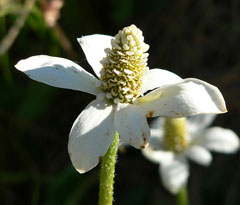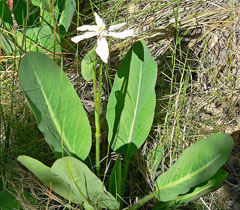 |
|
http://commons.wikimedia.org/wiki/User:Stan_Shebs |
 |
| http://commons.wikimedia.org/wiki/User:Stan_Shebs |
Translate this page:
Summary
Yerba mansa (Anemopsis californica) is a striking wetland perennial of the Southwest and Pacific states, recognized for its medicinal rhizomes and nutritious seeds. While the roots and rhizomes are strongly aromatic and traditionally used in teas for colds, lung ailments, and wound-washing, they have little food value and are best avoided as forage. Instead, the seeds provide a reliable edible resource, mild in flavor, easy to harvest, and versatile when boiled, toasted, or ground. Yerba mansa thrives in alkaline marshes, springs, and wet soils, spreading by rhizomes to form dense colonies, and plays an important role in stabilizing wetland ecosystems. Hardy in USDA zones 6–10 and tolerant of saline conditions, it is not a weed but rather a specialist plant of its ecological niche. Edibility rating: 3/5 – edible seeds, medicinal roots, important culturally and ecologically.
Physical Characteristics

 Anemopsis californica is a PERENNIAL growing to 0.5 m (1ft 8in).
Anemopsis californica is a PERENNIAL growing to 0.5 m (1ft 8in).
See above for USDA hardiness. It is hardy to UK zone 8. The species is hermaphrodite (has both male and female organs).
Suitable for: light (sandy), medium (loamy) and heavy (clay) soils. Suitable pH: basic (mildly alkaline) soils and can grow in very alkaline and saline soils.
It can grow in semi-shade (light woodland) or no shade. It prefers wet soil and can grow in water.
UK Hardiness Map
US Hardiness Map
Synonyms
Houttuynia californica.
Plant Habitats
Pond; Bog Garden;
Edible Uses
Edible Parts: Root
Edible Uses:
Seeds of yerba mansa are the only reliably edible part. They can be eaten raw, toasted, or boiled into a starchy, slightly sweet mush with a copper tint, and all methods of cooking yield good results. The flavor is mild, hearty, and faintly minty-evergreen, with none of the bitterness, acridness, or harsh notes that mark many wild seeds. Toasting enhances their grain-like flavor and softens their texture, making them excellent as a staple-type wild food. In contrast, the rhizomes and roots, though aromatic and technically chewable after long boiling, are best regarded as medicinal rather than edible. Fresh rhizomes are pink, fragrant, and tough, with a complex aroma reminiscent of mints, citronella, and geraniums. Even after prolonged cooking, their flavor is strong, acrid, and only marginally palatable, with little food value [2-3]. Edibility rating: 3/5 – Seeds are a solid food resource; roots and rhizomes should be avoided for food use and reserved for medicine [2-3]. Root - raw or cooked[257]. An aromatic flavour[94]. The pulverized seeds are made into bread or cooked as a mush[257]. The peppery aromatic root is astringent and is chewed raw for medicinal purposes[207].
References More on Edible Uses
Medicinal Uses
Plants For A Future can not take any responsibility for any adverse effects from the use of plants. Always seek advice from a professional before using a plant medicinally.
Analgesic Antiperiodic Antiphlogistic Antiseptic Astringent Blood purifier Diuretic Stomachic
TB VD Vulnerary Women's complaints
Yerba mansa is one of the most important traditional medicinal plants of the Southwest US. Decoctions or teas of the rhizomes were used as a blood purifier, pain reliever, and laxative, as well as for treating colds, lung conditions such as asthma and pleurisy, and for washing wounds. The tea causes a numbing effect on the tongue and mouth, echoing its traditional use for soothing discomfort. Dried rhizome pieces were sometimes chewed as a breath freshener. In ecological terms, yerba mansa forms dense colonies around springs and wetlands, stabilizing soil, filtering water, and creating microhabitats for aquatic life [2-3]. Yerba mansa was widely employed by the native North American Indians to treat a wide variety of complaints[257]. It is little used in modern herbalism. The whole plant is analgesic, antiperiodic, antiphlogistic, blood purifier, disinfectant, diuretic, laxative, stomachic and vulnerary. The plant is infused and used to bathe aching muscles and sore feet[1, 46, 61, 71, 94, 103, 207]. The root is chewed for affections of the mucous membranes[207]. A tea made from the root is used as a blood purifier and general pain remedy, and as a treatment for pleurisy, gonorrhoea, syphilis and menstrual cramps[207, 257]. An infusion of the plant is used in the treatment of colds, chest congestion and stomach ulcers[257]. The dried and powdered plant is used as a disinfectant on wounds whilst the fresh moist leaves are used as a poultice or salve on burns, cuts and wounds[257]. An infusion of the bark is used as a wash for open sores[257].
References More on Medicinal Uses
The Bookshop: Edible Plant Books
Our Latest books on Perennial Plants For Food Forests and Permaculture Gardens in paperback or digital formats.

Edible Tropical Plants
Food Forest Plants for Hotter Conditions: 250+ Plants For Tropical Food Forests & Permaculture Gardens.
More

Edible Temperate Plants
Plants for Your Food Forest: 500 Plants for Temperate Food Forests & Permaculture Gardens.
More

More Books
PFAF have eight books available in paperback and digital formats. Browse the shop for more information.
Shop Now
Other Uses
Beads
Beads can be made from the rootstock[94, 103, 207].
Special Uses
References More on Other Uses
Cultivation details
Yerba mansa grows in springs, marshes, and wet soils across the Great Plains, Southwest, and Pacific Coast, often in alkaline areas where few other plants thrive. It is highly tolerant of wet, saline, and alkaline conditions, and it typically forms dense colonies around permanent or seasonal water sources. Plants bloom from March through September, with seed production peaking from late summer into late autumn. Requires shallow water or a wet muddy site in a humus-rich alkaline medium[1]. Requires a warm position[187]. Plants are hardy to about -5 to -10°c, and are probably hardiest when the rootstock is submerged[200]. Another report says that they are hardy to about -15°c[187]. A perennial spreading by thick rhizomes, yerba mansa forms extensive colonies when conditions are suitable. It is well adapted to wetlands and can persist in sites with high salinity or alkalinity that limit competitors. Its showy white involucral bracts give the impression of a single flower but are actually clusters of small flowers. Yerba mansa is perennial and likely hardy in USDA zones 6–10, tolerating both cold winters (if rhizomes are insulated by soil or water) and extreme desert heat, provided soil remains moist.
References Carbon Farming Information and Carbon Sequestration Information
Temperature Converter
Type a value in the Celsius field to convert the value to Fahrenheit:
Fahrenheit:
The PFAF Bookshop
Plants For A Future have a number of books available in paperback and digital form. Book titles include Edible Plants, Edible Perennials, Edible Trees,Edible Shrubs, Woodland Gardening, and Temperate Food Forest Plants. Our new book is Food Forest Plants For Hotter Conditions (Tropical and Sub-Tropical).
Shop Now
Plant Propagation
Seed - best sown in a greenhouse as soon as it is ripe in the summer. Stand the pots in about 3cm of water and germination should take place in about 5 weeks[274]. Sow stored seed in a cold frame in the spring[111]. When large enough to handle, prick the seedlings out into individual pots and grow them on in the greenhouse for their first winter. making sure you keep the compost wet. Plant them out in late spring or early summer. Division in spring[200].
Other Names
If available other names are mentioned here
Native Range
NORTHERN AMERICA: United States (Kansas, Oklahoma, Colorado (south), Oregon, New Mexico, Texas, Arizona, California (south & central), Nevada, Utah (Utah & Washington Cos.)), Mexico (Baja, Sonora (north))
Weed Potential
Right plant wrong place. We are currently updating this section.
Please note that a plant may be invasive in one area but may not in your area so it's worth checking.
Yerba mansa does not behave as a weed outside its wetland niche. It is limited by its dependence on moist or marshy soils, though within its preferred habitat it can dominate sites by spreading rhizomes.
Conservation Status
IUCN Red List of Threatened Plants Status :

Growth: S = slow M = medium F = fast. Soil: L = light (sandy) M = medium H = heavy (clay). pH: A = acid N = neutral B = basic (alkaline). Shade: F = full shade S = semi-shade N = no shade. Moisture: D = dry M = Moist We = wet Wa = water.
Now available:
Food Forest Plants for Mediterranean Conditions
350+ Perennial Plants For Mediterranean and Drier Food Forests and Permaculture Gardens.
[Paperback and eBook]
This is the third in Plants For A Future's series of plant guides for food forests tailored to
specific climate zones. Following volumes on temperate and tropical ecosystems, this book focuses
on species suited to Mediterranean conditions—regions with hot, dry summers and cool, wet winters,
often facing the added challenge of climate change.
Read More
Expert comment
Author
(Nutt.)Hook.&Arn.
Botanical References
71200270
Links / References
For a list of references used on this page please go here
Readers comment
| Add a comment |
|
If you have important information about this plant that may help other users please add a comment or link below. Only comments or links that are felt to be directly relevant to a plant will be included. If you think a comment/link or information contained on this page is inaccurate or misleading we would welcome your feedback at [email protected]. If you have questions about a plant please use the Forum on this website as we do not have the resources to answer questions ourselves.
* Please note: the comments by website users are not necessarily those held by PFAF and may give misleading or inaccurate information.
To leave a comment please Register or login here All comments need to be approved so will not appear immediately.
|
Subject : Anemopsis californica
|
|
|
|